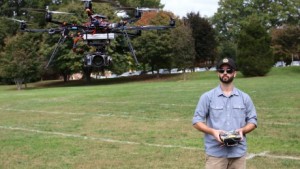Several news agencies have published stories recently about unique research conducted by Max Messinger and Miles Silman in the Department of Biology. Dr. Silman’s group is making use of “flying robots” to photograph and measure data from the forest canopy. Messinger is the local expert on how to turn these small multi-bladed helicopters into a platform for visual and thermal imaging.
Will Ferguson from the WFU news service describes the scene: “Soaring over a dense canopy of trees, a flying, insect-like robot developed by Wake Forest researchers will give an unprecedented look at Peru’s tropical cloud forest, one of the world’s most biodiverse ecosystems.”
Click here to view this article from Will Ferguson: From one forest to another
The Silman research group was also featured by El Comercio, one of the largest news organizations in South America. Click here to read the article: Investigadores usarán aviones no tripulados para estudiar el Manu
Their article quotes Messinger: “La única otra alternativa es alquilar un helicóptero, que es demasiado caro para cualquier tipo de observación continua”, agregó Messinger. Uno de los drones se parece a un helicóptero. Tiene ocho hélices pequeñas y puede volar a 24 km/h durante 20 minutos. Es capaz de llevar consigo una luz convencional o una cámara térmica para recoger datos de hojas y flores y temperatura. Asimismo, debido a su capacidad de vuelo estático, puede registrar el comportamiento animal.

Max Messinger, graduate student and expert in research drones flys his “robot” on the WFU practice field
Find more like this: Climate, ecology, Faculty, Miles Silman, plants, Research, silman , Climate, Ecology, Plants, Research
